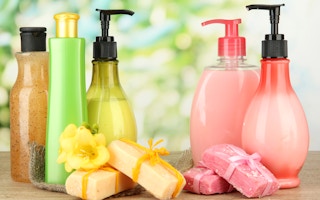Generally speaking, we’ve all become a bit greener in the kitchen. Sales of organic foods, ethically traded foods, (semi) healthy foods, “natural” foods, and foods with any other vaguely green label have shot up in recent years. While these foods used to be exclusive to health shops and upscale retailers such as Whole Foods, they have now gone mainstream, with Walmart now offering affordable organic foods, undercutting the competition by 25 per cent.
In the bathroom, however, we have been making less progress. Sustainability issues in the personal care industry get far less media attention, and sustainably-branded personal care products haven’t yet made it out of the health shops. Leading companies in the industry have largely taken a reactive approach to sustainable product innovation, such as phasing out micro-plastics in response to increasing pressure from stakeholders.
In order for the personal care industry to catch up with the food industry, we need companies to push product innovation beyond incremental change and use it to solve the main issues in the personal care industry: chemicals, packaging & recycling, and water use.
Chemicals
We all avoid certain food ingredients. For some people it’s E-numbers, for some its sugar or highly-processed food stuffs. I personally stick to Michael Pollan’s food rule: Do not eat foods that contain ingredients you cannot pronounce. I often catch people studying food labels in the supermarket, carefully considering the product’s ingredients before making a purchase, whether that’s to count calories or to spot E-numbers.
You never see people examining the back label of a bottle of shampoo, though. Admittedly, there is a difference between what you put into your body and what you put onto your body, but we know that many of the chemicals we place on our skin do get into our bloodstream.
So what exactly is in your bottle of shampoo and can it really harm you? The Guardian recently produced a handy infographic, uncovering mysterious ingredients in shampoos such as Phthalates and Sodium Lauryl Ether Sulfate.
It turns out we are a bit better off in Europe, where 1377 substances have been banned for use in cosmetics, whilst the FDA has only banned 11 ingredients in the United States. But there is hope for those across the pond, as federal regulations are expected to be updated this spring.
Packaging & Recycling
“
Sustainability issues in the personal care industry get far less media attention, and sustainably-branded personal care products haven’t yet made it out of the health shops.
We’re also much better at recycling food packaging than we are at recycling beauty and personal care products. 97 per cent of us claim to recycle regularly from the kitchen, but only 50 per cent of us prevent bathroom products from going to landfill. Companies haven’t made it easy for us either, as cosmetic products are often sold in multi-material, non-recyclable packaging.
Only a couple of companies have used innovation to tackle the packaging problem in the personal care industry. Unilever has set a new standard for deodorant by compressing the same amount of spray in a 25 per cent smaller can. More ground-breaking innovation comes from companies like CleanPath, which sells highly-concentrated cleaning products that you mix with water in your own home, and Method, whose Cradle-to-Cradle certified products include a soap bottle made from recovered ocean plastic.
Water
Our bathroom products consist mostly of water. Shampoo is about 80 per cent water, and toothpaste can be up to 40 per cent water. However, as Unilever’s product analyser shows, a bigger problem is the amount we use to wash our hair or brush our teeth, especially for those in water-scarce countries.
The personal care industry doesn’t offer us many alternatives apart from dry shampoo, which has only recently become popular but has been around for centuries (think distinguished gentlemen powdering their wigs). A quick search tells me there is a company specialising in waterless bathing, personal hygiene and sanitising products, aimed at festival goers and hospital patients. But it’s safe to say that it will be a while before it becomes socially acceptable to wash without water.
Raising the (soap) bar
We still have a long way to go before sustainable personal care products can be expected to go mainstream, but there are some things happening behind the scenes. In the US, Target and Walmart are collaborating in a Beauty and Personal Care Sustainability Summit organised by Forum for the Future, which aims to accelerate innovation.
Big and powerful companies such as Target and Walmart could be leading the way in a revolution in the personal care and beauty industry, benefitting both the environment and our personal health. We need one of these companies to take the lead and push sustainable bathroom products into the mainstream, and the rest will follow. We, as consumers, just need to give them a little nudge to let them know the demand is there.
I’ll be expecting edible toothpaste (including the tube), powdered nail polish remover, and maybe even a bottle of bath foam that eventually dissolves in water. But for now, some more refill options and concentrated products will do.
Manon is a graduate Researcher at Corporate Citizenship. This post is republished from Corporate Citizenship Briefing.


















